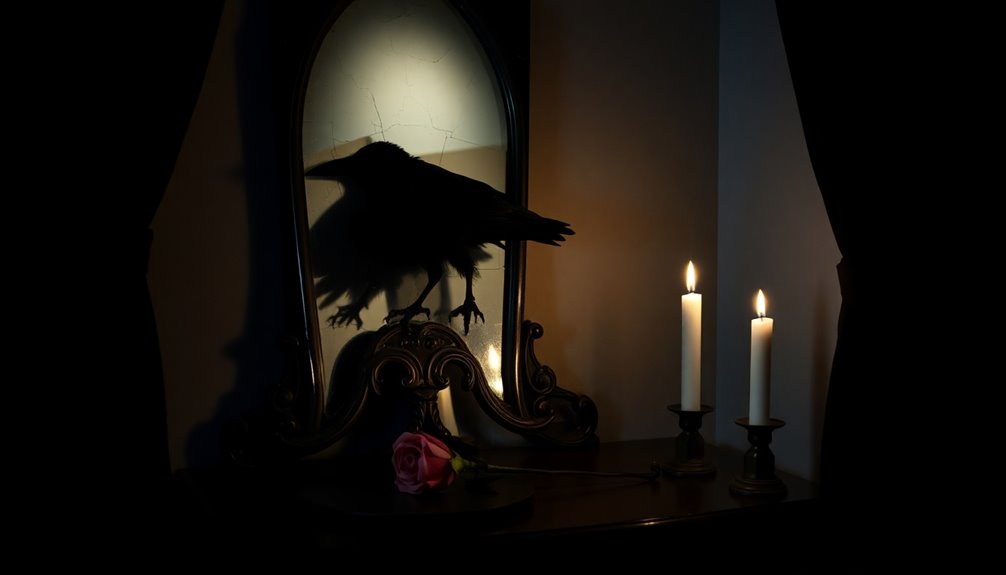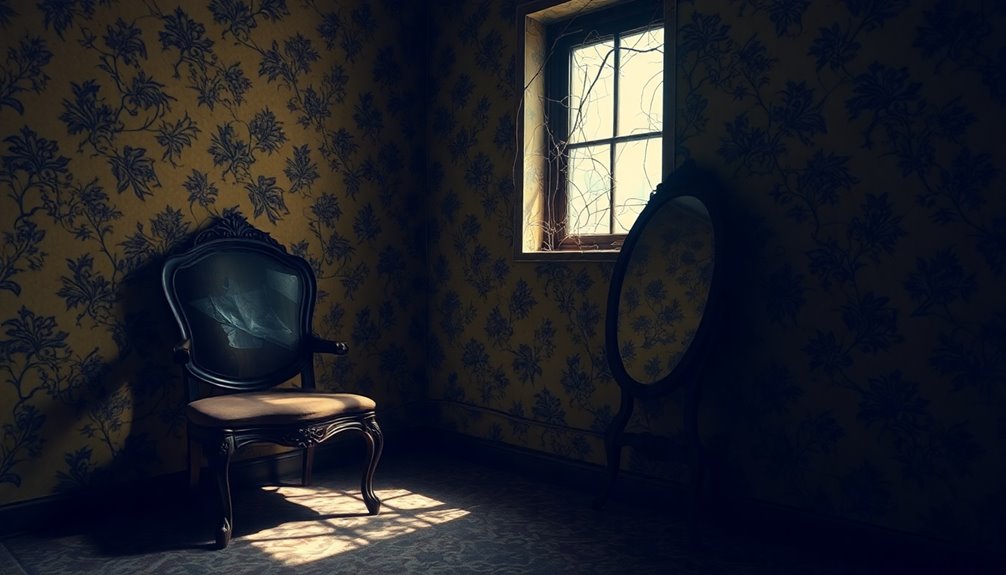Edgar Allan Poe uses symbolism to make his stories come alive with emotions and deeper meanings. You'll find symbols like the raven, which represents grief, and the old man's eye in "The Tell-Tale Heart," symbolizing guilt. Nature often reflects growth, with changing seasons showing different stages of life. In "Annabel Lee," the moon and stars symbolize everlasting love. Meanwhile, "The Masque of the Red Death" features colored rooms representing life stages and a ticking clock as a reminder of time slipping away. Each symbol invites you to explore your feelings and think about life and death, so let's uncover more together!
Key Takeaways
- Poe employs symbolism to convey complex themes such as love, death, and human emotion, enriching his narratives with deeper meanings.
- Notable symbols, like the raven and beating heart, reflect characters' inner struggles and emotions, enhancing the story's emotional depth.
- Seasonal and celestial imagery in poems like "Annabel Lee" symbolizes growth, innocence, and the timeless nature of love.
- In "The Masque of the Red Death," colored rooms represent life's stages, while the ebony clock signifies the inevitability of death.
- Vivid imagery and metaphors in Poe's works evoke profound emotions, inviting readers to reflect on the human condition and the nature of existence.
Overview of Symbolism in Poe's Works
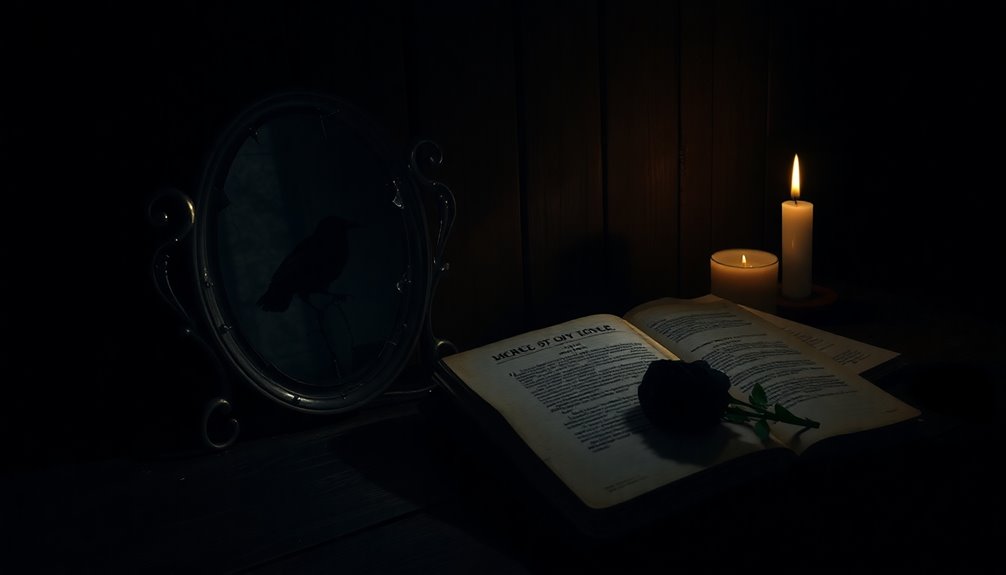
In many of Edgar Allan Poe's works, symbolism plays an essential role in conveying deeper meanings and emotions. When you explore Poe's stories, you'll find that he uses symbolism to explore complex themes like life, love, death, and human nature.
For instance, the raven in "The Raven" symbolizes grief and loss, while the beating heart in "The Tell-Tale Heart" represents guilt and paranoia. These symbols aren't just random; they reflect the struggles and feelings of the characters.
Poe's works are rich with symbolism and imagery that enhance the emotional depth of his stories. Take a moment to think about the moon and stars in "Annabel Lee." They symbolize the timeless qualities of love, showing how it can be both beautiful and haunting.
Symbolism in "Annabel Lee"

In "Annabel Lee," you can see how childhood innocence and love shine through the beautiful imagery.
The moon and stars create a magical feeling, showing that the speaker's love for Annabel is everlasting, like the night sky.
As you explore the poem, you'll find that these symbols help paint a picture of both joy and sadness, reminding us how special young love can be.
Childhood Innocence and Love
Symbolism plays an essential role in conveying the theme of childhood innocence and love in Edgar Allan Poe's "Annabel Lee." The speaker's deep affection for Annabel is beautifully captured through the moon, reflecting the dreamy and romantic essence of their youthful connection. This poem showcases how love can be pure and innocent during childhood.
Here's a table that highlights some key symbols in "Annabel Lee":
| Symbol | Meaning |
|---|---|
| The Moon | Represents the dreamy love between the speaker and Annabel. |
| The Kingdom | Symbolizes an idealized past, evoking childhood memories. |
| Changing Seasons | Reflects the bittersweet nature of growing up and love. |
| Stars | Suggests that true love lasts forever, even after loss. |
Poe's use of symbolism gives you a glimpse into the beauty of childhood love. The kingdom by the sea is a magical place where their love flourishes. You can feel the innocence and joy in every line. Nature imagery adds depth, reminding you how love and loss are part of life's cycle. Overall, "Annabel Lee" captures the essence of childhood love in a way that's both touching and unforgettable.
Celestial Imagery and Eternity
Celestial imagery permeates "Annabel Lee," creating a powerful connection between love and eternity. When you read the poem, you can feel how the stars and moon add a magical touch to the speaker's feelings for Annabel. Here are some key points to reflect upon:
- The moon shines brightly, symbolizing both beauty and the pain of longing.
- The phrase "kingdom by the sea" evokes a dreamy, perfect past where their love thrived.
- Stars represent eternity, showing that true love lasts even after death.
- The imagery invites you to contemplate love, loss, and cherished memories.
As you explore "Annabel Lee," the celestial imagery deepens your understanding of how the speaker connects love to eternity. The moon lights up the memories of Annabel, making you feel both joy and sorrow.
You can sense that their love is timeless, as if their souls remain intertwined in the cosmos. Poe skillfully uses celestial symbols to remind you that love isn't just for this world; it can transcend into something everlasting.
This beautiful connection makes "Annabel Lee" a touching exploration of love and longing that resonates through time.
Nature as a Symbol of Growth

In Edgar Allan Poe's stories, nature plays a huge role in showing how we grow and change.
Think about how spring brings fresh starts and reminds us of childhood innocence, while autumn hints at the bittersweet moments of growing up.
Childhood Innocence in Nature
Nature often reflects the purity and simplicity of childhood, capturing the essence of innocent love in Edgar Allan Poe's poetry. In "Annabel Lee," you can see how nature symbolizes childhood innocence and the beauty of young love. Here are some key points to examine:
- The moon represents the idealized nature of young love.
- The kingdom by the sea evokes nostalgia for simpler times.
- Celestial symbols, like stars, showcase the timelessness of childhood emotions.
- Seasonal imagery highlights the growth and changes in love.
Poe uses these elements to show how nature mirrors the joy and innocence found in childhood. The moon, shining brightly, reminds you of how pure love feels, untouched by adult worries.
The kingdom by the sea symbolizes a cherished past, where love was simple and innocent. Celestial symbols connect those feelings to something even bigger, like the universe itself.
With spring representing new beginnings, Poe illustrates how childhood innocence blossoms into something beautiful. Through this symbolism, you can appreciate the magic of young love and the way nature reflects its simplicity and beauty.
Seasons Reflecting Emotional Change
As childhood innocence gives way to the complexities of adulthood, seasons in Poe's works serve as powerful symbols of emotional change. You can see how each season reflects different feelings. Spring, for example, brings new beginnings and youthful love. In contrast, autumn captures the bittersweet nature of growing up. Poe connects nature to the characters' emotions, making you feel their journeys deeply.
Here's a table to highlight these seasonal changes:
| Season | Emotion |
|---|---|
| Spring | New beginnings |
| Summer | Joy and passion |
| Autumn | Change and nostalgia |
| Winter | Loss and reflection |
In "Annabel Lee," the idealized kingdom by the sea shows the purity of young love, evoking nostalgia. As the seasons progress, you notice how love evolves. It becomes more complex, reflecting the emotional growth and loss that come with maturity. Celestial imagery, mixed with seasonal changes, reminds you that love can endure life's transformations. Through these symbols, Poe invites you to explore the beauty and challenges of emotional change, making his stories resonate on a personal level.
Emotional Impact of Imagery
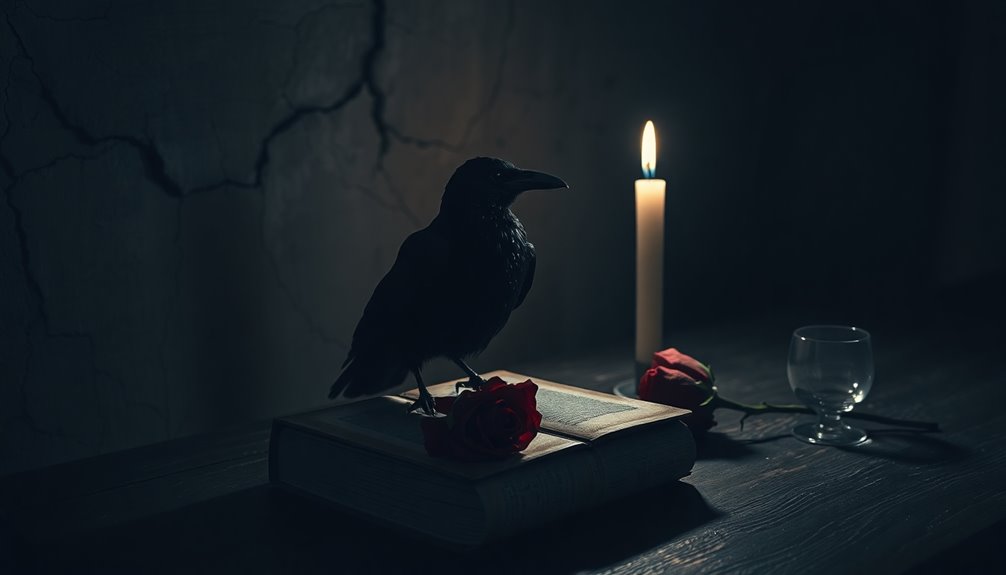
Through the vivid imagery found in Edgar Allan Poe's works, you can feel the raw emotions of love and loss come to life. His powerful use of symbols and imagery creates strong connections to what you might feel in your own heart.
Here are four ways Poe's imagery impacts your emotions:
- Metaphors and Similes: These figurative language tools paint bright mental pictures that stir feelings deep within you.
- Ethereal Beauty: In "Annabel Lee," the descriptions of beauty make you sense the sorrow of loss.
- Natural Imagery: The changing seasons reflect the ups and downs of romance, mirroring your own experiences.
- Symbols of Eternity: Elements like the moon and stars link love and longing, enhancing the emotional impact of nostalgia.
Poe uses imagery to invite you to reflect on your own emotions. As you immerse yourself in his stories, you connect with universal themes of love, grief, and maturity.
The emotional impact of his vivid descriptions pulls you into his world, making you feel every word. So, get ready to explore these feelings and find joy in the beauty of his writing!
Key Symbols in "The Masque of the Red Death"
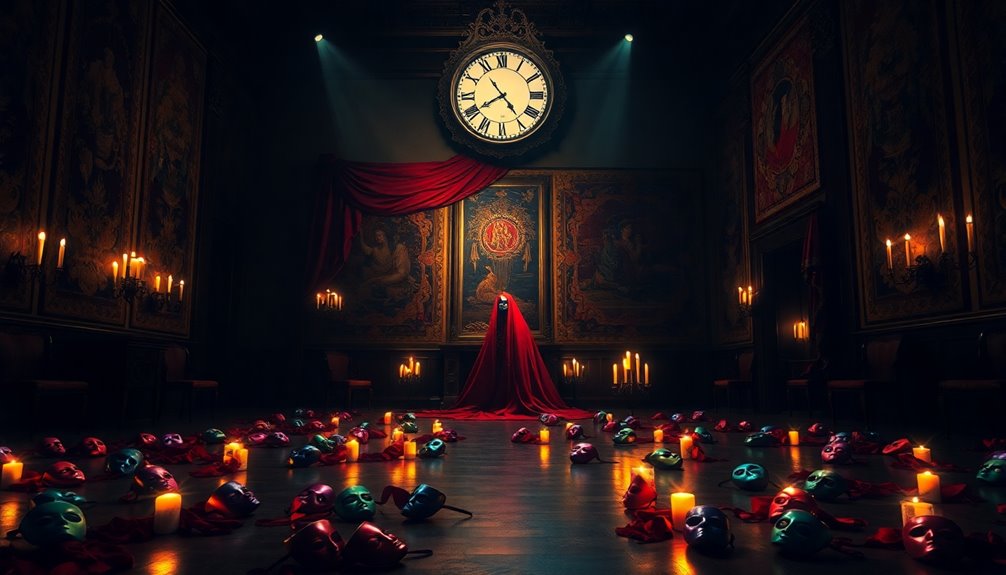
Edgar Allan Poe's "The Masque of the Red Death" is rich with symbols that deepen the story's exploration of mortality and human denial. One key symbol is Prince Prospero. He represents the illusion of control and privilege, as he tries to escape death by hiding in a lavish abbey.
The grand masquerade itself shows how society often pretends to be carefree while hiding its fear of death. Poe also uses the seven colored rooms in the abbey to symbolize the stages of life. As you move from east to west, you journey from birth to death, with the black room marking the end.
The ebony clock adds tension, reminding everyone that time is slipping away and death is approaching. Lastly, the grave-shrouded mummer is a powerful symbol of death's inescapable presence. This figure signals the end of the masquerade and highlights the story's theme: no one can escape their fate.
Through these symbols, Poe invites you to reflect on life, death, and the illusions we create to cope with our fears. The "Masque of the Red Death" teaches us that pretending doesn't change reality.
Analysis of Major Symbols
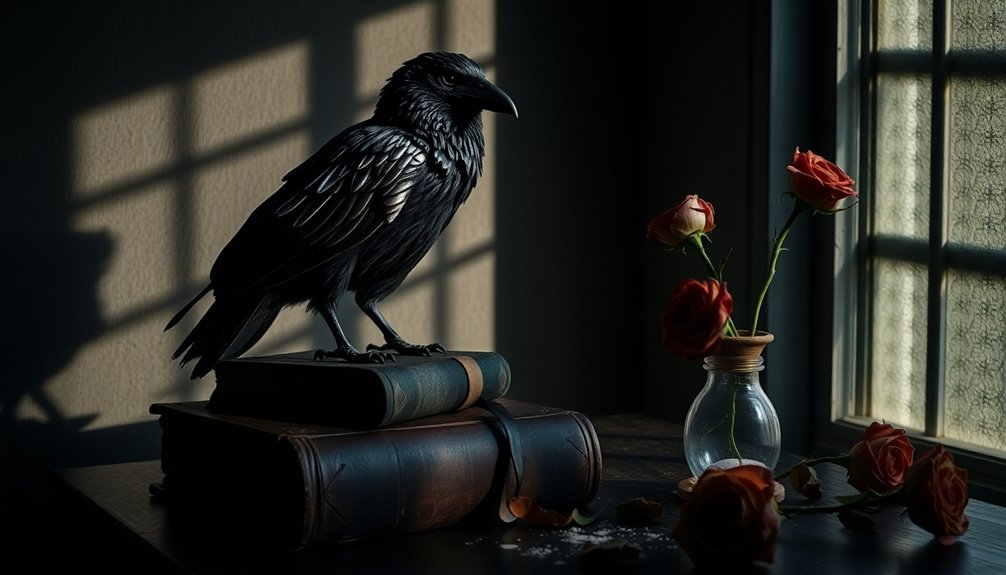
Poe's use of symbolism extends beyond "The Masque of the Red Death," impacting several of his notable works. Here are some major symbols you should know:
- The raven in "The Raven" represents death and mourning.
- The old man's eye in "The Tell-Tale Heart" symbolizes guilt and paranoia.
- The colors in "The Masque of the Red Death" reflect life's stages.
- Fortunato's jester costume in "The Cask of Amontillado" shows the danger of appearances.
In "The Raven," Poe uses the symbol of the raven to illustrate the protagonist's deep sorrow over lost love. Its repeated "nevermore" echoes his unending grief.
Meanwhile, the old man's eye in "The Tell-Tale Heart" highlights the narrator's madness and obsession, making you feel the weight of his guilt.
The vibrant colors in "The Masque of the Red Death" remind us of life's journey, from birth to death.
Finally, Fortunato's jester costume cleverly reveals how foolishness can lead to dire consequences.
Through these symbols, Poe's literary works invite you to explore complex emotions and human experiences.
Themes of Love and Maturity
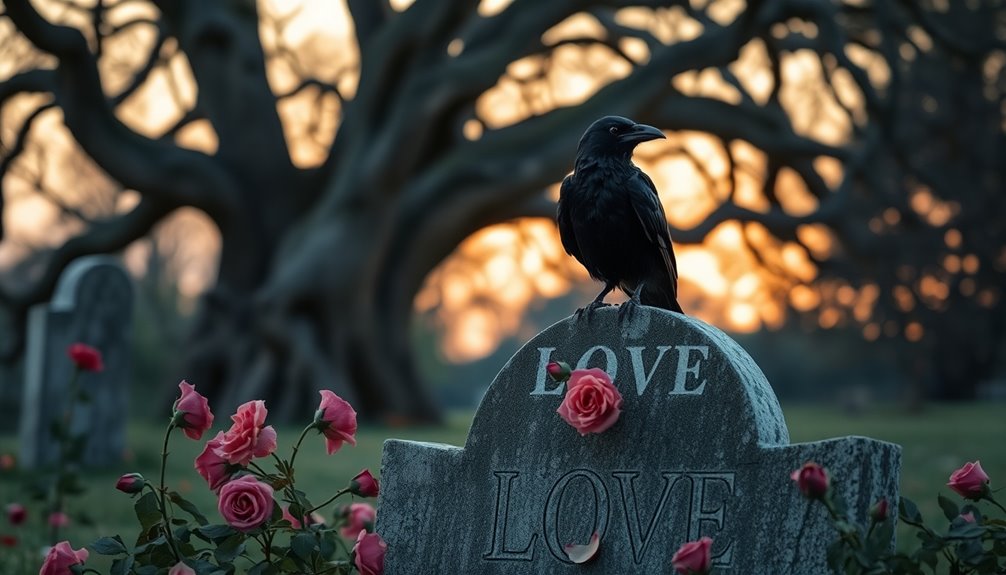
While exploring themes of love and maturity in Poe's works, you'll find that his portrayal of young love is both enchanting and poignant. In "Annabel Lee," for example, he uses the moon to symbolize the magical nature of young love. The stars represent a timeless bond that lasts even beyond death. This idea resonates with many readers, as it reflects how love can feel eternal.
Poe also employs seasonal imagery, changing from spring to autumn, to showcase how love can grow and change over time. This mirrors the bittersweet journey of growing up. The kingdom by the sea evokes nostalgia and purity, reminding you of the innocence of young relationships.
To help you understand these themes better, here's a quick summary:
| Symbol | Meaning | Example from Poe's Work |
|---|---|---|
| Moon | Ethereal nature of young love | "Annabel Lee" |
| Stars | Timeless bond of lovers | "Annabel Lee" |
| Seasonal Imagery | Maturation and bittersweet love | Change from spring to autumn |
Through vivid descriptions, Poe invites you to reflect on your own experiences with love and growing up. Additionally, the exploration of love often parallels the journey of personal growth, emphasizing the importance of motivation for success in navigating relationships.
Recommended Readings for Further Exploration
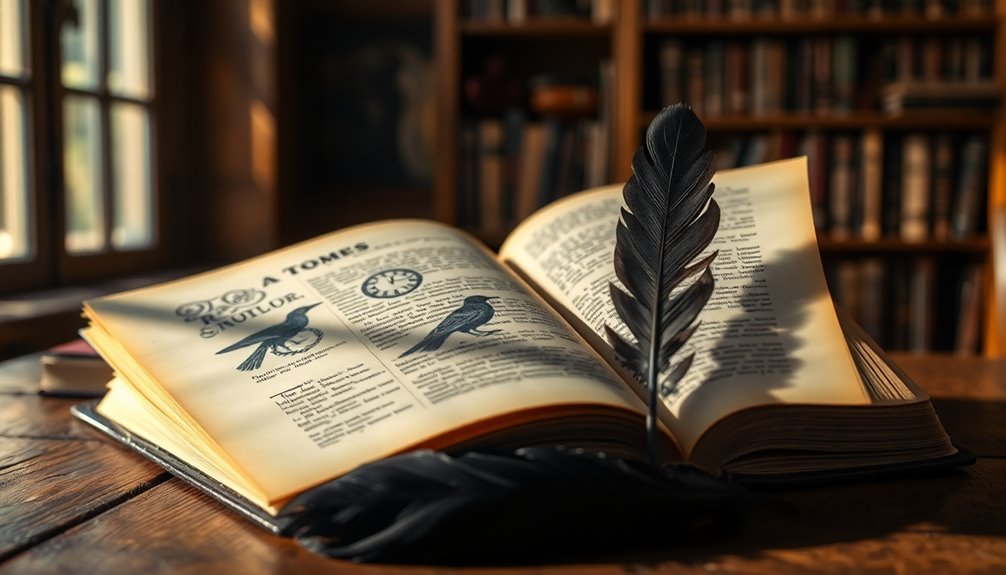
To dive deeper into the rich symbolism found in Poe's works, several recommended readings can enhance your understanding and appreciation. Here's a list to get you started:
- "Annabel Lee" – This poem reveals the beauty of love through dreamy imagery, making you reflect on the nature of true affection.
- "The Tell-Tale Heart" – In this gripping tale, the old man's eye symbolizes guilt and paranoia, showing how our minds can play tricks on us.
- "The Masque of the Red Death" – Here, the colorful rooms represent different life stages, and the ebony clock reminds us that time waits for no one, emphasizing life's fleeting moments.
- "The Raven" – This haunting poem features a raven that symbolizes endless grief, and the word "nevermore" perfectly captures the sorrow of loss.
These readings won't only entertain you but also help you discover the layers of meaning in Poe's writing. Each story and poem opens a door to new ideas, making you appreciate the depth of his symbolism even more.
Enjoy exploring these enthralling works!
Frequently Asked Questions
How Does Poe Use Symbolism in the Story?
Poe uses symbolism in his stories to share deeper meanings and emotions.
For example, in "The Masque of the Red Death," the colorful rooms represent life's stages, showing how everyone eventually faces death.
The raven in "The Raven" symbolizes loss and grief, echoing the pain of memories.
Each symbol you encounter adds layers to the story, making you think and feel.
This clever use of symbols keeps you engaged and sparks your imagination!
What Is the Use of Symbolism in Edgar Allan Poe's the Raven?
In "The Raven," symbolism is like a treasure map that leads you through the narrator's deep feelings.
The raven itself stands for death and the sorrow of losing someone you love. When it repeatedly says "nevermore," it emphasizes the hopelessness he feels.
The dark setting of midnight adds to the sadness. Each symbol, from the raven to the bust of Pallas Athena, helps you understand the mix of wisdom and madness in his grief.
What Are Some Examples of Symbolism in Annabel Lee?
In "Annabel Lee," you'll find some beautiful symbols!
The moon represents the magical love between the speaker and Annabel, creating a dreamy atmosphere. The stars symbolize their eternal bond, showing that love lasts even beyond death.
The kingdom by the sea brings a sense of nostalgia, reminding you of youthful memories. Also, the changing seasons reflect how love grows and changes over time.
Each symbol deepens the poem's emotions about love and loss!
What Is the Symbolism in Edgar Allan Poe's the Tell-Tale Heart?
In "The Tell-Tale Heart," you'll discover fascinating symbols that reveal the narrator's mind. The old man's eye represents your guilt and paranoia, making you feel watched.
Then, there's the beating heart, which symbolizes overwhelming guilt that drives you to confess. The watch highlights time's unyielding march, adding pressure.
Finally, the dark house mirrors your inner chaos, while hiding the body shows that you can't escape your conscience.
It's a thrilling exploration!
Conclusion
To sum up, Edgar Allan Poe's use of symbolism adds depth to his stories, making them exciting and full of meaning. You might think symbolism is too complex, but it's really just a way to show feelings and ideas through simple images. Whether it's the beautiful "Annabel Lee" or the eerie "Masque of the Red Death," each symbol helps you connect to the characters and themes. So immerse yourself in Poe's world—it's a thrilling adventure waiting for you!

